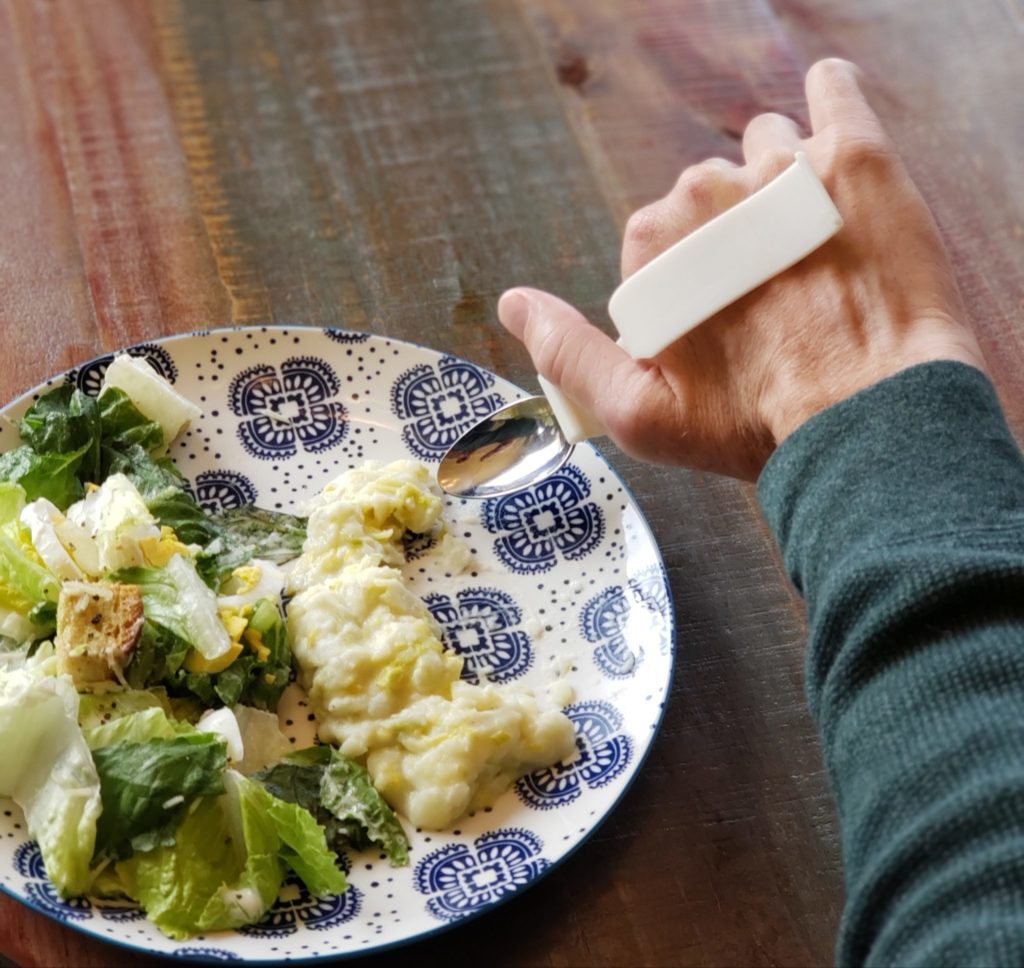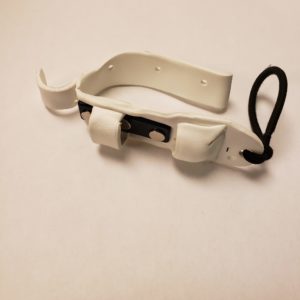
When sitting down to enjoy a meal, how often do you think about your ability to grasp your dining utensils in your hand? Most people don’t think twice when picking up their fork to transport a tasty morsel from plate to mouth. But, for people with a physical disability, this simple task can be challenging. While working with clients, Colorado State University occupational therapy alumnus Andrew Flint (’17) was inspired to help, leading to the invention of a new accessible technology, the MagnaCuff.
While attending CSU, Flint, a graduate of the Master of Occupational Therapy program in the Department of Occupational Therapy, was instilled with the mindset that disability tends to exist in an individual’s environment, and not always within the individual. As a result, he now observes how someone’s environment is falling short of meeting their unique needs and examines ways to modify their surroundings and provide them with adapted tools that not only improve their participation in the things they find meaningful but decrease their reliance on others. Flint also credits one of his occupational therapy professors, David Greene, for his role in helping him explore how various conditions alter the way the body moves and functions.
“He depicted how the hand, arm and shoulder move with the use of very creative three-dimensional models made from wood, pulleys, string and cardboard tubes that showed how the body functions when it is healthy compared to when there is dysfunction,” explained Flint.
As a result, Flint was able to see how the body compensates for deficits and adopts new ways to accomplish tasks, whether that be in a different way or with the assistance of an adapted device. Through this process, he found his passion for looking for and developing creative solutions for his patients through adapted devices.
Seeing the need
Upon graduating from CSU, Flint began working in the inpatient spinal cord injury unit at Craig Hospital in Englewood, Colorado, just south of Denver. A dream job for Flint, he worked with patients as they re-learned how to eat meals with limited, or completely absent, finger function following a spinal cord injury. The act of picking up a utensil, maintaining a grip on it, and manipulating it to pick up food and bring it to the mouth is incredibly challenging if your fingers no longer work the way they used to, or at all. Flint, along with his clients, was getting frustrated with the limitations that current commercially available adapted eating devices had. Many required the assistance of a caregiver to get the device on and off the hand, which did not promote a dignified eating experience.
“I noticed that the enjoyment of eating meals was missing for my patients, and I wanted to create a device that brought back some of that satisfaction and independence,” said Flint.
One day, Flint had a revelation. He realized that most eating utensils are made of metal, so why not use a strong magnet to pick up and hold onto a fork or spoon for someone with impaired finger function? And just like that, the idea for the MagnaCuff emerged.
Producing innovation

With the idea for a new adapted device burning in his mind, Flint began working on a prototype. The first MagnaCuff was made of splinting material and a name-badge magnet. Low tech, but highly effective. It was at this time that Joe Fangman, a mentor to Flint and physical therapist, encouraged him to enter his invention into an adapted device competition at the annual conference for the Academy of Spinal Cord Injury Professionals in Nashville in 2019. The MagnaCuff prototype won the Low-Tech category in the Innovation Lab competition, which energized Flint to further develop the device and produce it commercially.
While the splinting material and name badge magnet were great for a prototype, it was time to produce a sleeker design. Flint quickly recruited the help of Raj Ball, a rehabilitation engineer intern at Craig Hospital, and the prototype gave way to a 3D-printed model ready to make waves in the rehabilitation community.
How it works

The ergonomic shape of this life-changing assistive eating device fits snugly around the palm of the hand and is able to be put on and removed independently by the user. The thumb loop holds the thumb in place and prevents it from accidentally dragging through the meal. The user then simply hovers the magnetic portion of the MagnaCuff over a stainless-steel fork or spoon, pauses for the utensil to attach to the strong neodymium magnet, and slides the utensil into the MagnaCuff with their other hand or against a stable object. At this point, the utensil is secured to the MagnaCuff and the user can focus on enjoying their meal and switch between utensils with ease.
Getting the word out
With 3D printed models ready to go, the MagnaCuff was primed to be used by clients. While it was designed for users with paralysis of the hands from spinal cord injuries, it is also a useful device for someone with any condition affecting the strength, coordination or sensation of the hand, including brain injury, multiple sclerosis, ALS, stroke, Parkinson’s, diabetes and others.
With the MagnaCuff eliminating the need for caregivers to help clients eat their meals, patients can spend more time socializing and enjoying mealtime rather than struggling to pick up, hold onto, switch between and manipulate their utensils.
Flint has used his connections with former CSU OT classmates to spread the word of his invention. Six rehabilitation facilities across the country are doing demos of the MagnaCuff and allowing patients to try the product and purchase it. According to Flint, one user with a spinal cord injury described the MagnaCuff as “a life changer,” and purchased one for each of his travel bags so that he would never show up to a restaurant or gathering without it.

Just like how using Siri or Alexa makes playing music or texting easier for most, products like the MagnaCuff make everyday life easier for people with disabilities who struggle to use standard devices or complete activities of daily living. Recognizing this, Flint is not planning on stopping with the MagnaCuff, and he hopes to develop a knife that interacts with the device and allows users to also cut their food.
“The hope is that the gap between mainstream technology and assistive technology continues to close, and that all devices will be designed with the broadest possible level of skills and abilities in mind,” added Flint.
The MagnaCuff, putting “independence back on the table,” is available on the official MagnaCuff website, where there is more information about the product. Follow along with the growth of MagnaCuff by following social media channels on Facebook and Instagram.
The Department of Occupational Therapy is a part of CSU’s College of Health and Human Sciences.